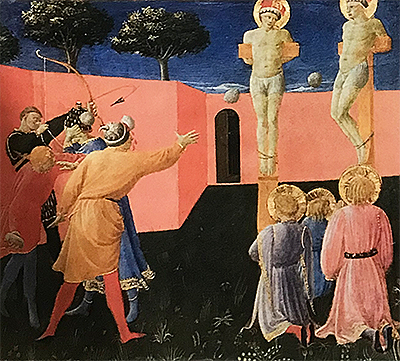The Crucifixion of Saints Cosmas and Damian is a powerful and dramatic fresco produced by Fra Angelico, perhaps in conjunction with members of his studio. The work arrived in around 1437-1440.
There were six episodes from the lives of the two saints which featured in a predella for the Annalena Altarpiece, although it took many years before historians were able to link together the main panel with this series of work. The predella was initially moved elsewhere and hung below a different artwork that wasn't even by Fra Angelico but eventually historians have worked out what its original intention was. Besides the six items, several other artworks perhaps were also part of this series, meaning it may actually numbered as many as nine in total. Perhaps the dimensions of these works in comparison with that of the larger panel might help us to understand how many were produced as normally the two rows would be of the same width. Each item in the predella was 23cm wide and around 20cm in height, creating a consistent tiled appearance in which a single theme, or life, is addressed. Crucifixion of Saints Cosmas and Damian occurs just before the last of the six which was The Martyrdom of Saints Cosmas and Damian.
The composition features the two saints with golden halos tied to wooden crosses on the right hand side of the painting. They have rope around their ankles and presumably around their wrists, though their arms are behind their backs. They look into each other's eyes with an expression of resignation and fear. Several of their followers are seen praying for their saviour, kneeling patiently. There are then the aggressive men on the left side who sport bows and arrows and point towards the saints, helping the viewer to understand the immediacy of the situation. A bright wall makes its way across the background, with a blue sky and trees appearing just above.
The artist was one of a number of important innovators with Florence and elsewhere across Italy who brought about considerable change within the nation's art. It would impact literature and sculpture as well as painting and architecture, with many of these ideas then spreading across the rest of Europe over the next few centuries. Some of the other contributors to this included Paolo Uccello, Masaccio and Giovanni Bellini and all of these great names would also be backed up by large studios who would help them to take on more work as well as then continuing their legacy by following a similar style generations after their death. The impact of the Renaissance was strongest most in Italy and also Northern Europe, with the latter bringing about the use of oils which would eventually be the favoured choice for Italians as well towards the end of the Renaissance - Fra Angelico would use egg tempera throughout his career in line with most at that earlier time.




